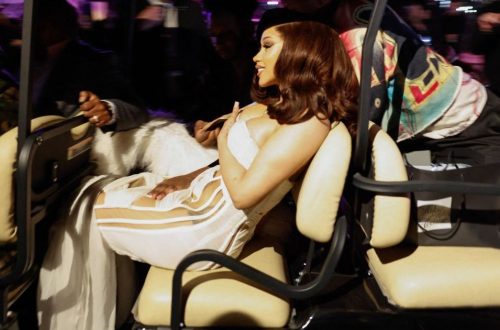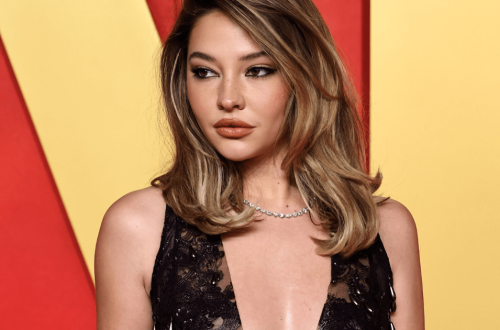Elizaveta Porodina has shot Vogue covers; she’s photographed campaigns for brands like Armani, Dior, Jean Paul Gaultier, and recently, Orebella; and she’s even released a book, Colormania, in collaboration with Carolina Herrera and the brand’s creative director Wes Gordon. But she does not think of her work as “fashion photography,” and upon viewing her images, that label doesn’t feel quite accurate. Rather, the clothes and beauty are tools and context for her artistic practice. Porodina’s abstract use of color, the otherworldly quality of her models—whom she refers to as muses and co-creators—and the expressiveness of their faces and bodies are a few striking qualities of her distinctive visual signature. Through close collaboration with her muses, she pushes into deep wells of emotion, delving into themes like isolation, alienation, and vulnerability. “I try to find people who have strong personalities, interesting points of view, a fantastic understanding of their body, and an openness to experimentation with body and mind,” she explains. “People who are attracted to the acting and exploring rather than, let’s say, posing or just superficial beauty…which is not to say that I’m not attracted to beauty, but I just find complex beauty more enchanting.”
Porodina’s drive to create has deep roots in her childhood. Born in Moscow, she moved to Munich when she was 12 and grew up poring over art books with her mother, developing an appreciation for iconography, form, and color. She studied opera and found early on that drawing and painting were powerful ways of connecting with people, something she had always struggled with before. But she describes eventually hitting limitations within these mediums, and after studying clinical psychology and feeling reluctant about committing to a career in the field, she became enraptured by photography in her early 20s. In photography, she found purpose, a means for collaboration and closeness with other people, and a boundless mode of expression. Here, we discuss the role of empathy in her practice, the fickle nature of flow state, and the importance of internal harmony.

Courtesy of Elizaveta Porodina
Coveteur: Do you ever use self-portraiture as a means of self-expression? Are you able to explore in ways that you can’t photographing other people?
Elizaveta Porodina: “I wouldn’t say that, to be honest, because I think it’s rather the other way around. When I have to do a self-portrait, and that’s mostly because no one else is around, I use it as a reminder to be empathetic and to ask of people only what I would do myself. For me, self-portraiture is more like an exercise in empathy rather than, ‘Oh, this is the true place of intimacy.’ I would rather say that my premise, in general, is to push people further than they thought they would go, but I don’t want to push them to a place where I myself would never go under any circumstances.”
I think empathy is one of the most important traits that artists can have. It really comes through in your photos.
EP: “Different artists say different things about that because, when you look at the art of other people, it sometimes appears as if empathy as a quality is frowned upon. I personally feel that you don’t need to break anyone and you don’t need to treat anyone badly to get true emotion. I think that you can access depth, suffering, or vulnerable places within people through empathy, kindness, participation, and witnessing.”
I read that you wanted to be an artist growing up and this was a life you wanted to pursue. What inspired these early aspirations?
EP: “I obviously want to give you a truthful, authentic answer, but the more I move away from my childhood, the more it all becomes a narrative and a story that I tell to myself rather than the ultimate truth. I assume, now, from what I remember, I was just really struggling to communicate with people properly, in verbal ways and the usual social ways. I felt isolated, shut out, and pretty much alone. I was either alone or surrounded by old people.
I remember when I was 13 or 14, the moments when I was appreciated, or not seen as a freak or a weirdo, were moments when I would draw. People would suddenly surround me, look over my shoulder, and ask me what I mean by these images. I feel almost a magical attraction that I start to exude when I create. I feel like I find my center and that I’m able to resort to a place where I’m interested in myself and in my own process, unlike at any other moment of my life, when I create—visually, with my voice, or whatever. I think that was pretty much the reason.”
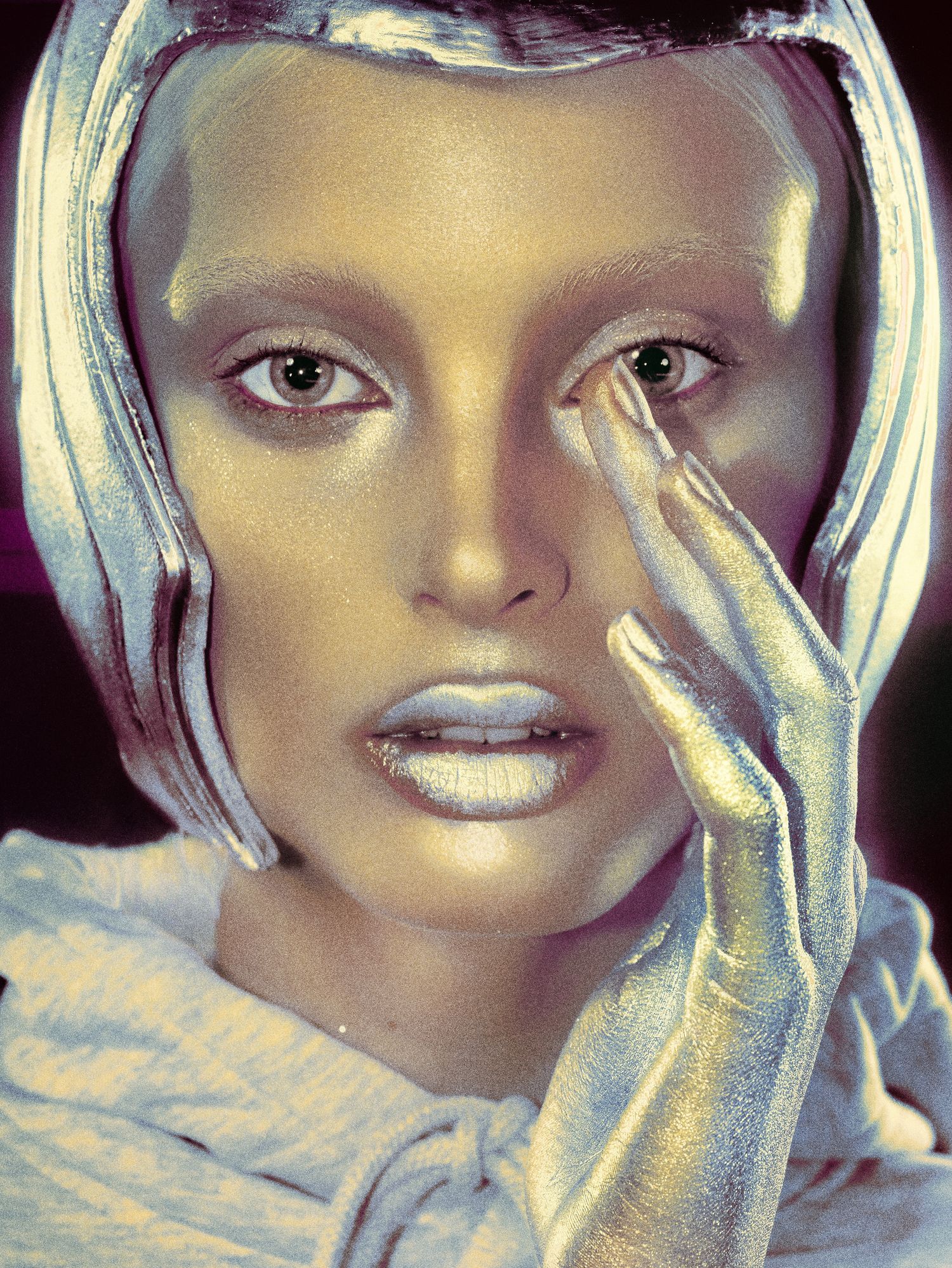
Courtesy of Elizaveta Porodina
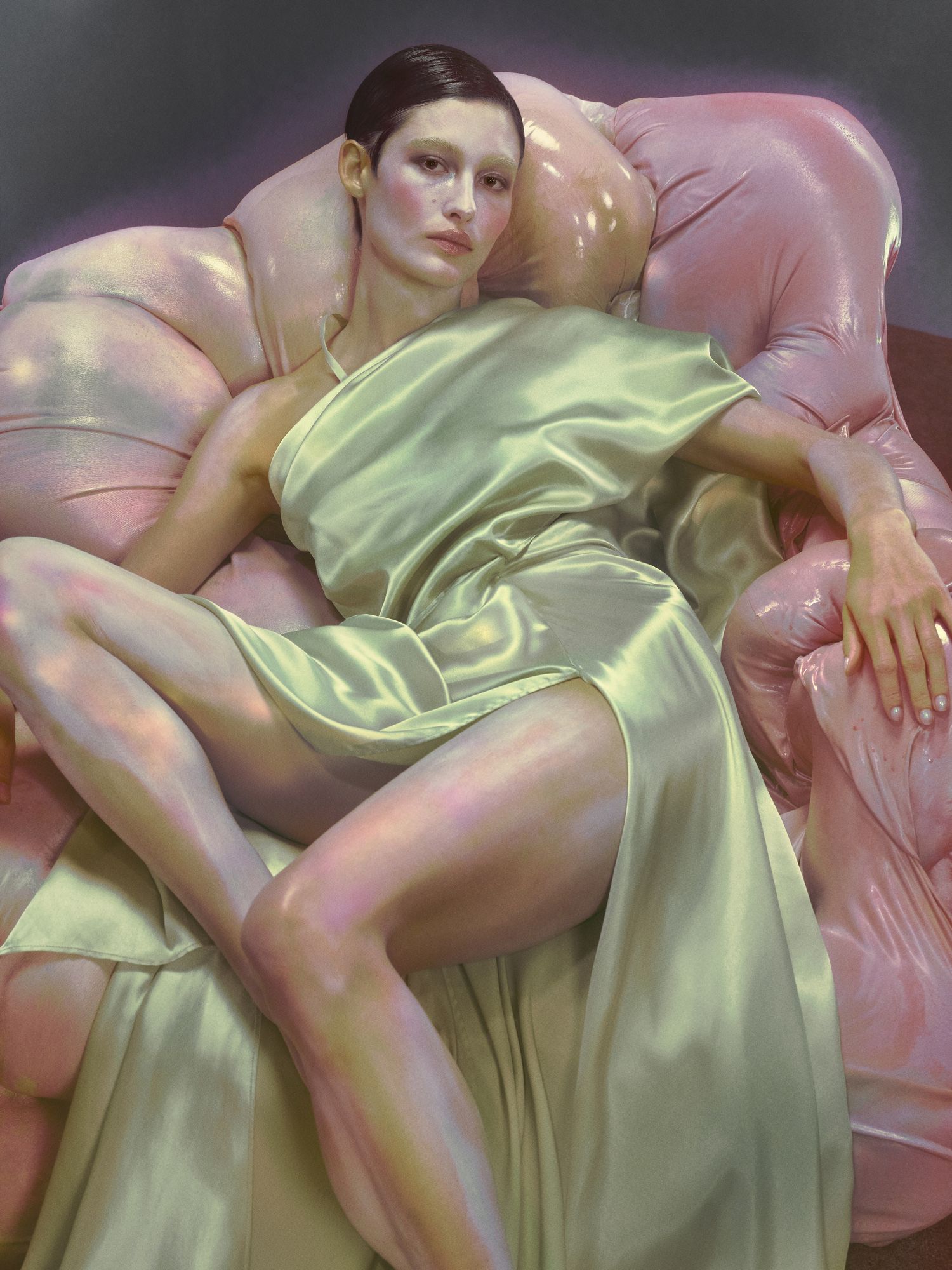
Courtesy of Elizaveta Porodina
Right, you used to sing opera.
EP: “Well, I wanted to sing opera, and I learned it. I took lessons for four or five years because I was under the impression that I would be Maria Callas [laughs]. Then I found out that I wouldn’t be. Basically, I found my limitations within my voice or, let’s say, more so my expressions. I was pretty disillusioned by that because I felt like, if I wanted to pursue something for my entire life, I’d rather not see any limits for a long, long time, so I decided to find something else.”
I wonder if there’s a similarity between any kind of creation, whether you’re singing, painting, or taking images. Creation lends itself, for me at least, to a hyper-focus and a difference in the body and the way I think. Is that something you experienced?
EP: “Well, you’re talking about the state of flow, right?”
Exactly.
EP: “Absolutely, 100 percent. I wouldn’t say that I’m able to reach it anytime, every time. Sometimes, it’s just hard work. I don’t want to romanticize this process because basically, as many other artists before me have said, you need to sit down and start working every day, be disciplined, and that muse, when she comes, when she decides to descend upon you, she better find you working. Some days are just walking through mud, working hard, and retrieving a couple of little diamonds, and some days are blessed with her presence. Or you can call it a state of flow, and I guess it’s pretty much the same thing.”
Were there any artists of any medium who captured your imagination when you were growing up who are still relevant and important to you?
EP: “Many. I think that was what my mom and I connected most over. She was taking me to exhibitions and theater plays, and growing up, art was a normal thing to consume. It was nothing out of the ordinary. We would sit down and look at many different art books, and I would marvel at how beautiful and strange the choice of colors would be, or how the figures that the artist chose would be completely out of the ordinary, so strangely unique and so much their own. This is something that I feel we both bonded over and what my mom taught me—to understand it freely and easily without imposing any rules upon myself.
I’ve seen a lot of artists that left a lasting impression. Matisse, Cézanne, Vrubel was a big, big thing. He has a painting that is called ‘Demon.’ I remember looking at this painting and being completely blown away by the dark romanticism behind the painting, how vast and beautiful the landscape was, and how the landscape and the colors represent both his internal emotions and something very archetypical. The magical, maybe biblical, iconography within it was really fascinating to me on a level that I wasn’t able to verbalize back then but definitely left a lasting impression.”

Courtesy of Elizaveta Porodina
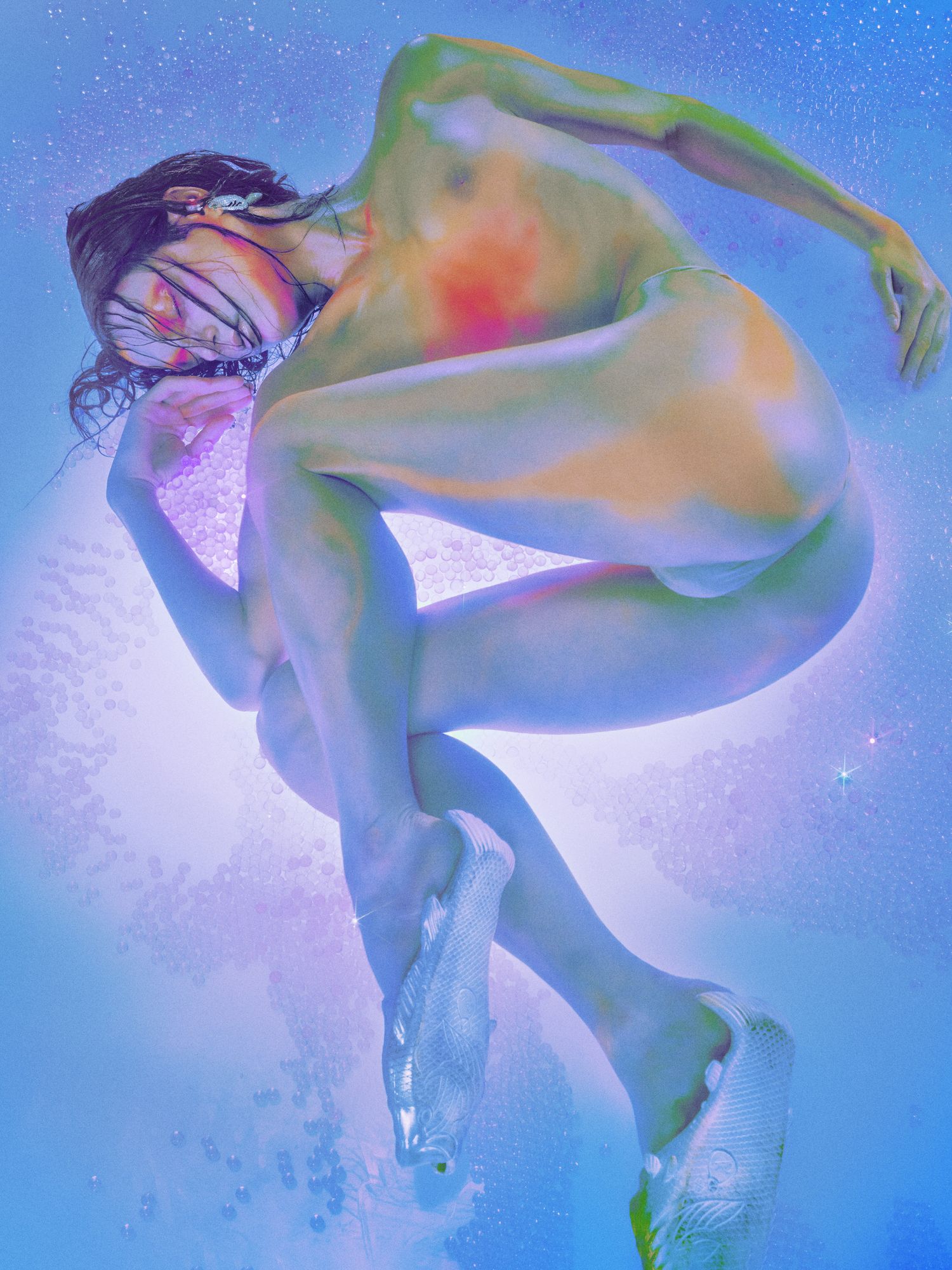
Courtesy of Elizaveta Porodina
When you were first approaching photography, did you think of it as an artistic medium and mode of expression or was it more as a practical hobby and skill to learn?
EP: “I started when I was 23 or 24. I definitely didn’t allow myself any hobbies back then. I didn’t feel worthy of having hobbies because I didn’t know what exactly to do with myself. I was studying psychology but knew already that that was not necessarily the path that I would want to go down. I felt pretty unworthy of having hobbies or spending leisure time until I found what I was actually going to do with my life. Anything that I would pick up on would be somehow in the bigger vein of finding a larger purpose for myself.
I was drawing and painting before, and with that, again, I found my limitation. I hit a wall. It dried up and the singing dried up. Again, I was alone and isolated. I was looking around me and trying to find a medium where I would have a lot to learn, and where I would not find any limitations. What attracted me to photography was the fact of extensive collaboration, specifically with that sort of photography, where you photograph different people, with a vehicle of fashion, makeup, or whatever. It was playful and theatrical. It allowed for extensive, limitless collaboration with so many different people, which also had a confrontational aspect to it because back then, I was pretty much afraid of everything and everyone. I probably was even afraid of going to a store and talking to people, so that sort of photography was a life exercise. Every shoot became like a test. ‘Can you do this? Can you stretch yourself further? Can you conquer that moment?’ I guess it was more that than a practical hobby.”
Did you start doing fashion photography pretty soon after you started taking photos?
EP: “I wouldn’t say that I ever called it fashion photography or ever saw it like that. At some point, maybe there was a need to name it somehow, but for me, it was just photography or just me doing my art, doing pretty much exactly the same thing that I was doing before. Even with painting or writing songs, it was just packing and unpacking archetypes that I find within myself, but with different mediums. I think that fashion can be a powerful vehicle to that because people choose to wear it on their bodies and they choose to, maybe consciously or subconsciously, express emotions with it, so it is a pretty magical tool.”
Do you find that your personal relationship with dressing and fashion has evolved since working in this field?
EP: “I don’t know if it’s changed since I was working in the field, because I’ve been working in the field for many years now, and I stayed pretty much the same for a long while. But a couple of years ago, I think I was on a KNWLS shoot. We were shooting Julia Fox and she was rocking these incredible pants that KNWLS does, and I was just so enchanted by these pants. I think in that moment, something in me clicked. I do think that people constantly change and evolve and that as a person and as a personality, you keep exploring different parts of your identity. Clothes, for me, are an expression of these changes and of these constant switches in the mosaic that is the human identity. I definitely experiment with clothes and color way more now. I found great fun in doing that and obviously, it’s a huge exercise for my profession, as well. Because the more you experiment with clothes yourself, the more you can speak, for example, to the styling department.”
Did you ever go through any phases with subcultural dressing?
EP: “Yeah. I was a goth. When I was a kid, I was pretty gothy.”

Courtesy of Elizaveta Porodina

Courtesy of Elizaveta Porodina
I love how you refer to your models as muses. Are there any energies or characteristics that are particularly inspiring to you?
EP: “Definitely. To me, casting and the models, the muses are a huge, super important aspect within my shoots. They’re completely non-exchangeable. I’m extremely collaborative in the sense that they are the co-creators of my work. It’s not like there was a blank spot and you could fill anyone in there; I try to find people who have strong personalities, interesting points of view, a fantastic understanding of their body, and an openness to experimentation with body and mind. People who are attracted to the acting and exploring rather than, let’s say, posing or just superficial beauty. That is the part that is not interesting to me, which is not to say that I’m not attracted to beauty, but I just find complex beauty more enchanting.”
You mentioned your struggle for connection as something you explore in your work. Is that something you actively consider in your approach or is that something that just imbues itself in the work in a more abstract way?
EP: “This is an exploration of a thing I find within myself, the isolation and the glass wall that somehow feels sometimes more opaque and sometimes less between me and other people, between me and environments. It’s a thing that I experience. Sometimes, it’s correlated to suffering. Sometimes, it’s just something that I observe without any emotion. Sometimes, it brings me joy, but it definitely is a very specific feeling that is very much mine. That’s why I’m trying to explore it, but I wouldn’t necessarily say that’s the only topic that I explore. It’s omnipresent, I would say.”
That reminds me of your images of the women in a sort of membrane. I was thinking of it as a rebirth but now I’m thinking of it more as that glass wall, that separation.
EP: “Isn’t it both? You’re protected, but alone, and alone, not protected.”
I like how the expression of that comes through these very otherworldly images. Like the way you render skin is almost airbrushed-looking. I was wondering if you think about that contrast between expressing these very human feelings and impulses with these figures that are almost extra-human.
EP: “I feel like this is a totally valid way of interpreting the otherworldliness and the sci-fi sort of thing, but to me, I think the direction that I’m also exploring is the three-dimensionality and the sculpturality of the skin and the body as almost an abstract object in space. That’s one of the aspects of the work, especially when I work on the image. I sometimes want the subject to almost jump at you from the image. I want them to be very, very almost hyper-realistic. Almost confrontational, if you want to say. I totally see how that can be perceived as otherworldly, as well. I don’t mind that.
Formally, I’m interested in color and exploration of sculpturality just as much as I’m interested in conveying a specific emotion that is human. I’m just as interested in just the formal harmony or disharmony of colors as a different layer of conveying a specific emotion.”
It’s more of a poetic logic.
EP: “Yeah, you could definitely say that. I intend it to be multi-layer, and I intend it to be perceptible on different layers. You can perceive the specific concept, you can perceive the expression within the eyes or a specific human emotion, but you can also perceive and take in things that maybe are hidden on different other levels that could be the formal level.”

Courtesy of Elizaveta Porodina
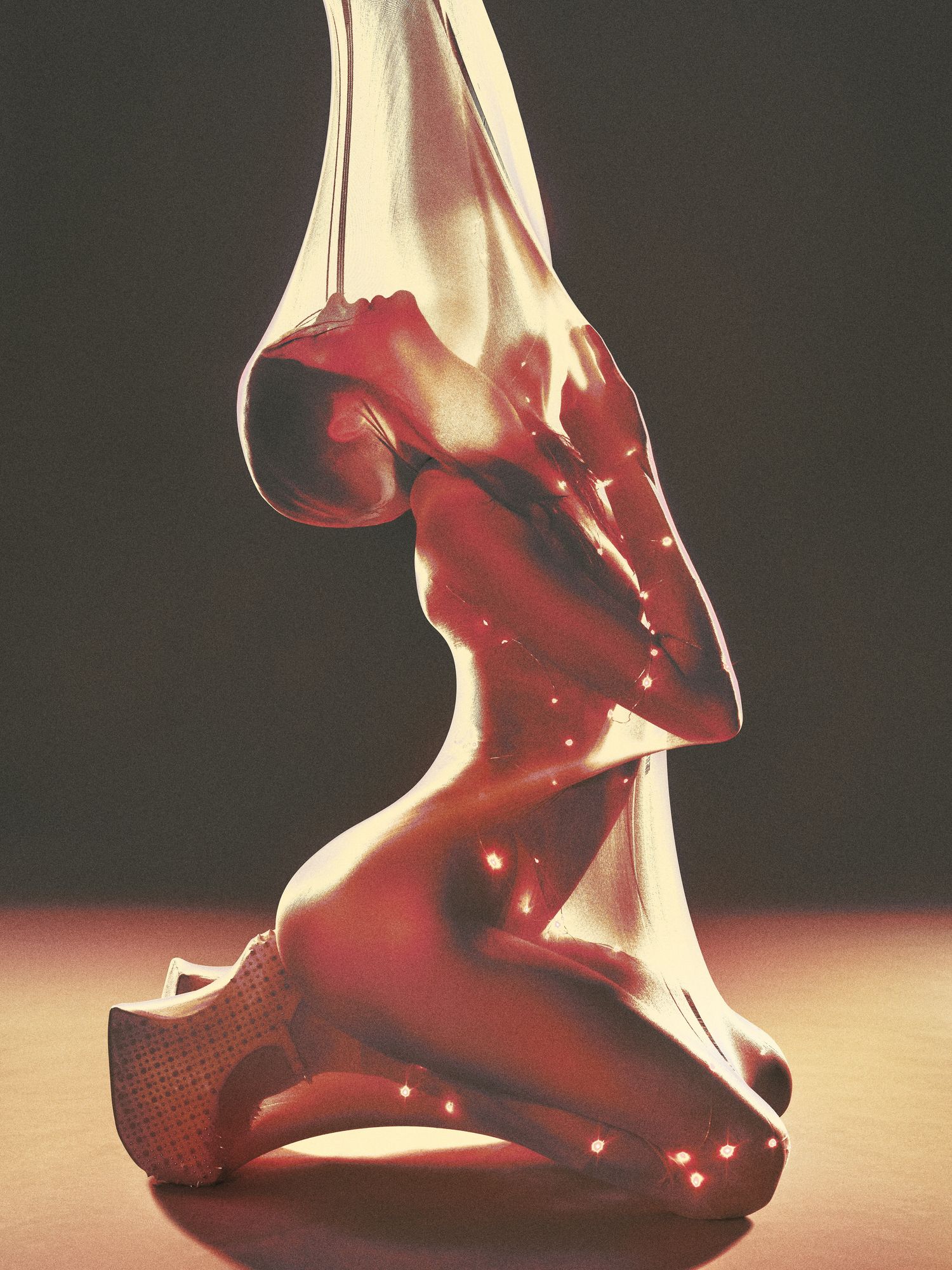
Courtesy of Elizaveta Porodina
I noticed that you engage your community a lot on Instagram in your captions. Why you do that and has anyone ever said anything that changed the way you think about an image?
EP: “To change my way, there would have to be a very set way that I’m thinking about them, which is not the case. I find that before you show them to anyone, they’re like your baby, your secret baby, and you have this secret relationship with them. Maybe you have your favorites or you have your thoughts about it, but they’re all very vague and very simultaneous. Once an image is out there, there is an audience, there is the air that the image breathes, and all kinds of reactions. When you put out an image, it could get a different meaning than what you were intending for it.
I chose to be quite fluid with that. I chose to be, or let’s say I constantly choose to be, a little bit more chill about that. I don’t want to be like, ‘Oh, that’s how I feel about this image and nothing can sway me.’ That’s why I ask because I want to hear the associations. I’m interested. It’s almost like a deck of tarot cards. There is room for interpretation and I like that. I love hearing people who are smart, insightful, and thoughtful sharing their associations. It’s a conversation with cool people who choose to look at my work.”
What you create is so personal to you before it hits the light of everyone else’s perception and then all of a sudden, this thing is now up to be consumed by people. It involves you because you made it but it’s also now theirs to have a relationship with.
EP: “It definitely is exactly like that. I will even go further and say, it’s not yours anymore that much, it’s theirs.”
Are there any artists who are particularly interesting to you right now?
EP: “I’m a huge fan of Miriam Cahn. I’m a big fangirl. I love Magdalena Abakanowicz. The thing is, I love art so much. I see so many different artists, and I appreciate everyone’s approach so much. I don’t necessarily look at things and go, ‘Oh, this is good,’ or, ‘This is bad,’ but I try to delve into their way of working. For example, I am fangirling hard about Sandra Hüller at the moment, the German actress. I think that she’s been doing incredible work and I love her approach. I love how earnest, authentic, and effortless her acting is and her work is, and how much inner work must be under it, almost like with an iceberg, where the tip looks so beautiful and majestic and there so much underneath the water, so much experience, so much depth.”
Has your relationship with photography evolved and are there ambitions and new horizons you want to reach with it?
EP: “I feel like I was when I was younger and when I was just starting, my ambitions were very big, and they were burning me up from the inside, and they were very external. It was very much like, ‘I would like to shoot this person and that person for that magazine,’ and all of that. Also, status and achieving a certain title. It felt very important and almost existentially crucial to reach these things.
I would say that it evolved in a sense that I want to achieve internal mountaintops more. I’ve rearranged myself in a way that I’m always trying to achieve my balance. Every day, I choose to find an internal harmony within myself, which can be just following certain routines, taking care of myself, respecting myself, finding out what I truly feel, and what I truly want. Which seems like it has nothing to do with these external things but, at least in my life, I found that it does because when you align yourself with you, all the other things tend to follow. All the things that are meant for you, that are right for you, that are bound to happen and that will feel good.
This is by no means me trying to do a TED Talk on being spiritual; this is just what I’ve found is working for myself. I had moments in my life where I was pushing very hard for something to happen and I always got what I wanted, but it never made me happy, as opposed to moments that just came to me, and I plunged into them and found myself surprised in the best way possible.”



